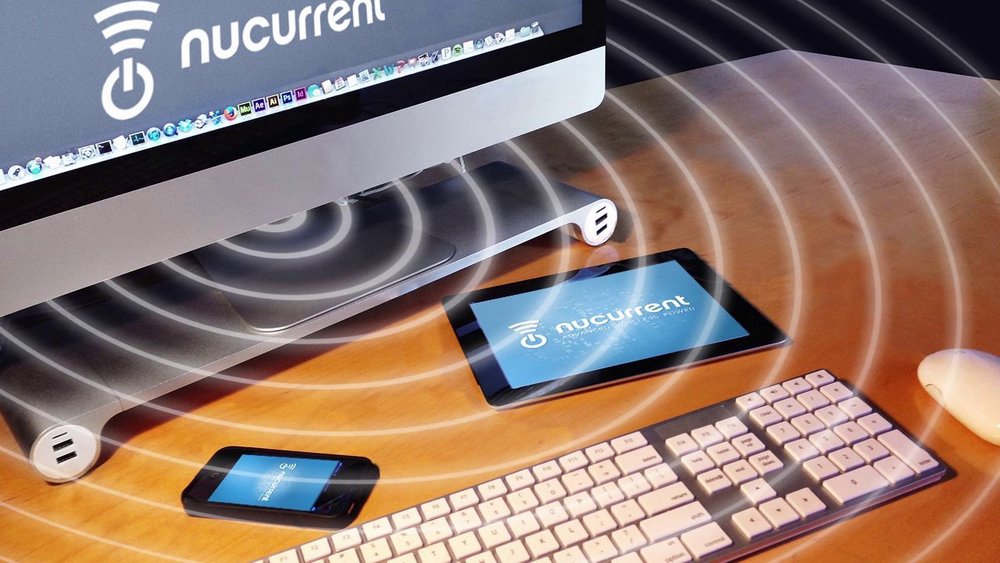by TODD STOLARSKI | April 3, 2015
NuCurrent brings wireless efficiency to the people
NOTE: In real life, you can’t see these charging waves.
For a firm that never planned on occupying the AEC space, Chicago-based wireless power provider NuCurrent Inc. sure seems at home there. Founded in 2009, the design startup’s initial focus was on wireless power for implanted medical devices. But as NuCurrent developed novel structures that dramatically reduced the impact of high frequency effects on inductors, it began focusing on non-medical applications in 2012. Its technology enables inductors to operate at high frequency while maintaining low resistance. Compared to standard models, NuCurrent’s antennas offer higher efficiency, smaller sizes, longer battery life, and lower heating with your circuit.
Grown out of Northwestern University’s Farley Center for Entrepreneurship + Innovation, the firm was started by Northwestern Law grad Jacob Babcocok, now its CEO, and Dr. Vinit Singh, an electrical engineer from North Carolina State University who serves as CTO. In 2013, the pair entered NuCurrent in the Illinois Science & Technology Coalition Corporate-Startup Challenge, where they met Lisle, IL-based Molex Inc., one of the world’s largest manufacturers of electronics connectors. A courtship ensued and in December, Molex signed on to be a strategic partner and minority investor. The deal has positioned NuCurrent to think globally.
Babcock, killin’ it in the cardigan!
And even though it has just five employees, in 2014 it was awarded 14 new patents. That total was enough to place the firm atop the new Crain’s Chicago Business Eureka Innovation Index, released earlier this week. BuiltWorlds recently had the chance to catch up with Babcock, back from a business trip to South Korea.
What market need brought NuCurrent into existence?
We started in 2009 with a focus on implanted medical devices to solve a problem of breakage due to scar tissue build-up around the device’s cord. We developed a breakthrough in high efficiency structures for wireless power antennas inside the human body and, for the past two years, have been migrating our business to the consumer electronics and industrial markets. These markets are more attractive for a young company due to higher volumes and lower lead times than compared to medical devices.
How does NuCurrent distinguish itself from the competition?
Other companies make wireless power antennas, but none of our competitors can compete with us on efficiency. Because of our patented, high-efficiency technology, we can help our customers with smaller antennas, which charge devices faster and do so over greater distances.
Look Ma, no wires!
Have you encountered any unexpected challenges trying to bring NuCurrent to the market?
Of course. There haven’t been any fatal challenges, and none come to mind, specifically, but we are always dealing with new challenges in this high-tech, high-volume business.
So much has changed in just the last 10 years. A decade from now, how will the industry be using your product?
In 10 years, no one will need power cords anymore to charge their phones, tablets, computers, power tools, etc. Everything will be “drop & charge”, where you can put all your power tools on a table and they will recharge without inserting them into a special cradle, or plugging them in. This will give unprecedented flexibility to users, as well as practical advantages, like waterproofing (no power ports = no need to waterproof them), dust proofing and ruggedization…
Game changer: Just four months ago, big-time manufacturer Molex signed a deal with NuCurrent to become “a strategic partner and minority investor”, according to the Chicago Tribune.
…In the AEC world, lighting will be much more flexible. We have developed a proof of concept with Molex (SSL) and Georgia Pacific (Drywall) to demonstrate wirelessly powering LEDs to light a room. The power source is embedded in the wall and you can simply place LEDs on the wall, over the source, and they will turn on.
* BONUS QUESTIONS *
When will robots take over all our jobs?
It already happened, on April 29th, 2011. Haven’t you seen The Terminator? We just don’t notice because we are living in The Matrix.
Did you get choked up by the first 15 minutes of the Pixar movie ‘UP’?
I haven’t seen it. Should I?
Well, ‘Yes’… but we digress.
Our thanks to to Mr. Babcock for taking the time to share his wireless wisdom with BuiltWorlds. Much more to come, we’re sure. For more, follow them on twitter @NuCurrentTweets.




Discussion
Be the first to leave a comment.
You must be a member of the BuiltWorlds community to join the discussion.